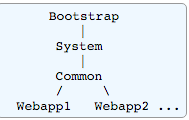ServletContext
When the servlet container (like Apache Tomcat) starts up, it will deploy and load all web applications. When a web application get loaded, the servlet container will create the ServletContext once and keep in server's memory. The webapp's web.xml will be parsed and every <servlet>, <filter> and <listener> found in web.xml, or annotated with respectively @WebServlet, @WebFilter and @WebListener, will be created once and kept in server's memory as well. For all filters, the init() method will also be invoked immediately. When the servlet container shuts down, it will unload all web applications, invoke the destroy() of all initialized servlets and filters, and finally the ServletContext and all Servlet, Filter and Listener instances will be trashed.
When the Servlet in question has a <servlet><load-on-startup> or @WebServlet(loadOnStartup) value greater than 0, then its init() method will also immediately be invoked during startup. Those servlets are initialized in the same order as load-on-startup value represents, or if they are the same, then the order in the web.xml or @WebServlet classloading. Or, if the "load-on-startup" value us absent, then the init() method will only be invoked on very first HTTP request hitting the servlet in question.
HttpServletRequest and HttpServletResponse
The servlet container is attached to a web server which listens on HTTP requests on a certain port number, which is usually 8080 in development and 80 in production. When a client sends a HTTP request, the servlet container will create new HttpServletRequest and HttpServletResponse objects and pass it through the methods of the already-created Filter and Servlet instances whose url-pattern matches the request URL, all in the same thread.
The request object provides access to all information of the HTTP request, such as the request headers and the request body. The response object provides facility to control and send the HTTP response the way you want, such as setting headers and the body. When the HTTP response is committed and finished, then both the request and response objects will be trashed.
HttpSession
When a client visits the webapp for the first time and the HttpSession is to be obtained for the first time by request.getSession(), then the servlet container will create it, generate a long and unique ID (which you can get by session.getId()) and store it in server's memory. The servlet container will also set a Cookie in the Set-Cookie header of the HTTP response with JSESSIONID as cookie name and the unique session ID as cookie value.
As per the HTTP cookie specification, the client is required to send this cookie back in the subsequent requests in the Cookie header as long as the cookie is valid. The servlet container will determine the Cookie header of every incoming HTTP request for the presence of the cookie with the name JSESSIONID and use its value (the session ID) to get the associated HttpSession from server's memory.
The HttpSession lives until it has not been used for more than the time, a setting you can specify in web.xml, which defaults to 30 minutes. So when the client doesn't visit the webapp anymore for over 30 minutes, then the servlet container will trash the session. Every subsequent request, even though with the cookie specified, will not have access to the same session anymore. The servlet container will create a new one.
On the other hand, the session cookie on the client side has a default lifetime which is as long as the browser instance is running. So when the client closes the browser instance, then the session will be trashed at the client side. In a new browser instance the cookie associated with the session won't be sent anymore. A new request.getSession() would return a brand new HttpSession and set a cookie with a brand new session ID.
In a nutshell
- The ServletContext lives as long as the webapp lives. It's been shared among all requests in all sessions.
- The HttpSession lives as long as the client is interacting with the webapp with the same browser instance and the session hasn't timed out at the server side yet. It's been shared among all requests in the same session.
- The HttpServletRequest and HttpServletResponse lives as long as the client has sent it until the complete response (the webpage) is arrived. It is not being shared elsewhere.
- Any Servlet, Filter and Listener lives as long as the webapp lives. They are being shared among all requests in all sessions.
- Any attribute which you set in ServletContext, HttpServletRequest and HttpSession will live as long as the object in question lives.
ThreadSafety
It's multithreaded and different threads can make use of the same instance. It would otherwise have been too expensive to recreate it on every request.
public class ExampleServlet extends HttpServlet {
private Object thisIsNOTThreadSafe;
protected void doGet(HttpServletRequest request, HttpServletResponse response) throws ServletException, IOException {
Object thisIsThreadSafe;
thisIsNOTThreadSafe = request.getParameter("foo"); // BAD!! Shared among all requests!
thisIsThreadSafe = request.getParameter("foo"); // OK, this is thread safe.
}
}
